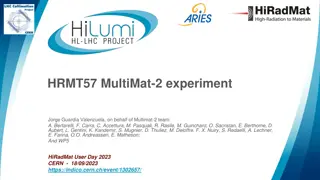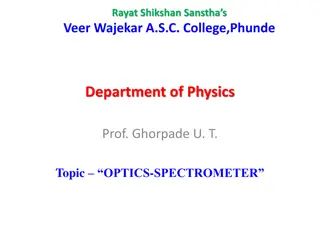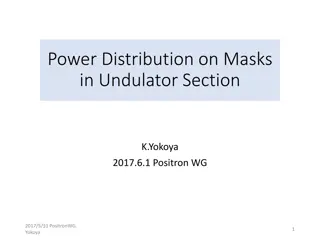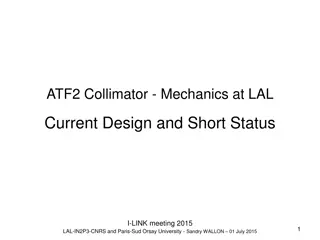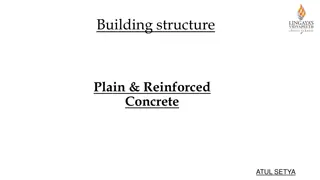
CEPC Collimator Design Overview
Explore the design and importance of collimators in the CEPC, addressing machine protection and beam loss scenarios. Learn about the energy considerations, collimator types, and optimization strategies for effective beam control and safety measures.
Download Presentation

Please find below an Image/Link to download the presentation.
The content on the website is provided AS IS for your information and personal use only. It may not be sold, licensed, or shared on other websites without obtaining consent from the author. If you encounter any issues during the download, it is possible that the publisher has removed the file from their server.
You are allowed to download the files provided on this website for personal or commercial use, subject to the condition that they are used lawfully. All files are the property of their respective owners.
The content on the website is provided AS IS for your information and personal use only. It may not be sold, licensed, or shared on other websites without obtaining consent from the author.
E N D
Presentation Transcript
CEPC collimator design Xiaohao Cui CEPC Day, 2025/03/21 1
1. Introduction The energy stored in the beam of CEPC is very high Machine protection considered for beam destruction Higgs W Z ttbar Energy (GeV) 120 80 45.5 180 Bunch Number 268 1297 11934 35 Bunch Charge (nC) 20.8 21.6 22.4 32 Energy/bunch (kJ) 2.5 1.73 1.02 5.76 Energy/beam (MJ) 0.67 2.24 12.17 0.2 2
For slow beam loss in the machine (The loss time is larger than several turns, t>1ms), we can use the beam dump system, to extract the unstable beam into the beam dump. For fast beam loss in the machine, we must have beam collimation system added in the ring for machine protection. 3
Collimation systems for: Suppress experimental backgrounds Global machine protection from unexpected beam loss Protect important elements, RF cavities, detectors, 4
2. Collimators arrangement Now there are two types of collimators in the ring MDI collimators MDI collimators -- mainly to reduce the background at IP Machine protection collimators Machine protection collimators mainly to protect the machine against abnormal beam loss. 5
After some simulation and optimization 19 MDI collimators: 12 machine protection collimators: 6
MDI collimators with aperture radius 3mm or 4mm Horizontal Horizontal Dispersion/ Dispersion/ m m Range of half Range of half width width allowed/mm allowed/mm Distance Distance to IP/m IP/m to Beta Beta function/m function/m name name Position Position Phase Phase BSC/2/m BSC/2/m APTX1 D1I.1042 44669 81.64 0.15 202.79 0.00711 1.4~7.1 U APTX2 D1I.1046 44728 89.97 0.15 QF 203.04 0.0073 1.4~7.3 U APTX3 D1I.2291 4969 90.04 0.15 QF 425.34 0.0073 1.4~7.3 U APTX4 D1I.2294 4915 89.97 0.15 QF 425.59 0.0073 1.4~7.3 U APTX5 D1O.10 1721 90.01 0.15 QF 7.00 0.0073 1.4~7.3 APTX6 D1O.14 1776 90.01 0.15 QF 7.25 0.0073 1.4~7.3 APTX7 D1O.1262 51418 90.01 0.15 QF 229.80 0.0073 1.4~7.3 APTX8 D1O.1264 51469 81.62 0.15 QF 230.05 0.0073 1.4~7.3 APTX9 19 307.40 0.006 444.85 0.01098 2.6~10.98 U APTY1 D1I.1051 44809 90.25 0.075 QD 203.38 0.0035 0.14~3.5 U APTY2 D1I.1054 44864 89.78 0.077 QD 203.63 0.0035 0.14~3.5 U APTY3 D1I.2299 4833 90.25 0.077 QD 425.99 0.0035 0.14~3.5 U ATPY4 D1I.2302 4778 89.78 0.077 QD 426.24 0.0035 0.14~3.5 U APTY5 D1O.16 1826 18.77 0.15 QF 7.31 0.0035 0.14~3.5 APTY6 D1O.19 1881 18.56 0.15 QF 7.56 0.0035 0.14~3.5 APTY7 D1O.1271 51578 18.77 0.15 QF 230.42 0.0035 0.14~3.5 APTY8 D1O.1274 51633 18.56 0.15 QF 230.67 0.0035 0.14~3.5 APTY9 D1I.1540 18307 81.95 0.079 QD 364.96 0.0035 0.14~3.5 U 7 APTY10 D1I.1543 18250 81.28 0.081 QD 365.21 0.0035 0.14~3.5 U
Machine protection collimators aperture radius 3mm 4 horizontal 4 horizontal betatron betatron collimators, installed in the straight sections, are collimators, installed in the straight sections, are used to block particles with large horizontal used to block particles with large horizontal betatron betatron oscillations oscillations for H betatron collimator 4 momentum collimators, installed in the arc sections, are used to 4 momentum collimators, installed in the arc sections, are used to block particles with large momentum deviations block particles with large momentum deviations for momentum collimator 4 vertical 4 vertical betatron used to block particles with large vertical used to block particles with large vertical betatron betatron collimators, installed in the straight sections, are collimators, installed in the straight sections, are betatron oscillations oscillations for vertical collimator After discussion with Yi Wei Wang, momentum collimators are moved After discussion with Yi Wei Wang, momentum collimators are moved to one side of an arc section to one side of an arc section 8
3. Simulation results 1. 1. RF failure: RF failure: Considering the RF cavity protection scenario, it is assumed that the RF cavity voltage decays exponentially after the protection is triggered, V(t)=V0 e t/ with a time constant of 773 s. 10
3. Simulation results 1. 1. RF failure: RF failure: Position of particle loss 11
3. Simulation results 2. Dipole failure Assume that dipole magnets in one arc section of the ring loses power, and its magnetic field decays exponentially with a time constant of 10ms B(t)=B0 e t/ 12
3. Simulation results 2. Dipole failure Position of particle loss 13
3. Simulation results 3. Quadrupoles failure Assume that all quadrupole magnets in the ring loses power, and its magnetic field decays exponentially with a time constant of 10ms B(t)=B0 e t/ 14
3. Simulation results 3. Quadrupoles failure Position of particle loss 15
4. Work to do 1. Optimize collimator setting and particle loss under quadrupole failure conditions 2. SAD-Fluka coupling simulation 16

